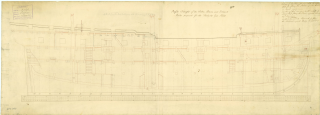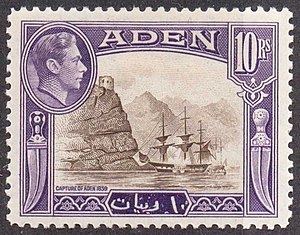
HMS Captain was a 70-gun third rate built at Woolwich Dockyard in 1677/78. After sitting in Ordinary for ten years she was in active commission for the War of the English Succession fighting at Beachy Head and Barfleur. She was in Ordinary until 1706 when she was rebuilt. She was in active commission for the last half of the War of Spanish Succession but fought in no major engagements. She was at the Battle of Passero I 1718. She was rebuilt in 1720/22. She made two forays in to the Baltic though the bulk of her late career was spent as guardship at Portsmouth. She was hulked in 1740 and finally broken in 1762.
HMS Burford was a 70-gun third rate ship of the line built at Woolwich Dockyard in 1677/79 as part of the Thirty Ships Programme of 1677. She fought in the War of the English Succession, including the Battle of Barfleur, before being rebuilt at Deptford in 1699, remaining as a 70-gun third rate. During the War of Spanish Succession she was mostly in the Mediterranean fleet and fought at the capture of Gibraltar and the Battle of Málaga in 1704 before being extensively repaired between 1710 and 1712 at Portsmouth Dockyard. Burford served in the Baltic in 1715 and 1717 before returning to the Mediterranean to fight the Spanish at the Battle of Cape Passaro in 1718. She was wrecked on the Italian coast in a storm on 14 February 1719.

HMS Eagle was a 70-gun third rate ship of the line of the Royal Navy, builtat Portsmouth Dockyard during 1677/79. When completed she was placed in Ordinary for 10 years. She was in active commission during the War of the English Succession partaking in the Battle of Barfleur. She was rebuilt in 1699 at Chatham. She again played an active role in the early part of the War of Spanish Succession participating in the Capture of Gibraltar, and the Battle of Velez Malaga. She was wrecked in the Isles of Scilly in October 1707.

HMS Expedition was a 70-gun third-rate ship of the line built at Portsmouth Dockyard in 1677/79. She was in active commission during the War of the English Succession participating in the battles of Beachy Head and Barfleur. She was rebuilt in 1699. Again, for the War of Spanish Succession she was in commission for the operation at Cadiz then returned to England where she sat for two years. She was in the Mediterranean for the Battle of Marbella in 1705. She then went to the West Indies and fought in Wager’s action off Cartagena in 1708. She was rebuilt in 1709-14 to the 1706 Establishment. She spent her time split between the Baltic and as guard ship at Portsmouth before being broken at Portsmouth in 1736. She was rebuilt in 1736/40 at Deptford Dockyard.

HMS Pallas was one of the three 36-gun Venus-class fifth-rate frigates of the Royal Navy. She was launched in 1757 and initially served in Sir Edward Hawke's fleet blockading the coast of France where she fought at the Raid on Cherbourg and in the Battle of Bishops Court. She later served for a number of years in the Mediterranean Sea before moving to serve off the coast of Africa between 1774 and 1776 where she protected the isolated British colonies. In 1778 she joined the Newfoundland Station and participated in the attack on Saint Pierre and Miquelon. Pallas returned to the English Channel after this and assisted in destroying a French invasion force intended for the Channel Islands in 1779 before briefly serving on the Jamaica Station. In 1783 she was beached on São Jorge Island after she was found to be heavily leaking; she was burned there on 24 February.

HMS Brilliant was a 36-gun Venus-class fifth-rate frigate of the British Royal Navy that saw active service during the Seven Years' War with France. She performed well against the French Navy in the 1760 Battle of Bishops Court and the 1761 Battle of Cape Finisterre, but was less capable when deployed for bombardment duty off enemy ports. She also captured eight French privateers and sank two more during her six years at sea. The Royal Navy decommissioned Brilliant in 1763. The Navy sold her in 1776 and she became an East Indiaman for the British East India Company (EIC). Brilliant was wrecked in August 1782 on the Comoro Islands while transporting troops to India.

HMS Arethusa was a 50-gun fourth-rate sailing frigate of the Royal Navy, was launched in 1849 from the Pembroke Dockyard and served in the Crimean War. In 1861 she was converted to a steam screw frigate. Decommissioned in 1874, Arethusa became a school and training ship on the River Thames, preparing young boys for maritime careers, until she was broken up in 1934.

HMS Magicienne was the lead ship of her class of two 16-gun, steam-powered second-class paddle frigates built for the Royal Navy in the 1850s. Commissioned in 1853 she played a small role in the Crimean War of 1854–1855 and was sold for scrap in 1866.
HMS Thisbe was a 46-gun modified Leda-class fifth-rate frigate built for the Royal Navy during the 1820s. The ship was never commissioned and spent her entire career in reserve or on third-line duties. She was converted into a depot ship in 1850 and then into a floating church in 1863. Thisbe was replaced by a shore-based establishment, All Souls Chapel, in 1891 and sold for scrap the following year.
HMS Druid was a 46-gun Seringapatam-class fifth-rate frigate built for the Royal Navy during the 1820s, the name ship of her sub-class.
HMS Forth was a 44-gun Seringapatam-class fifth-rate frigate built for the Royal Navy during the 1820s, one of three ships of the Andromeda sub-class. After completion in 1833, she was ordered to be converted into a steam-powered ship in 1845, but this did not happen for another decade.

HMS Talbot was a 28-gun Atholl-class sixth-rate frigate built for the Royal Navy during the 1820s.

HMS Seringapatam was a 46-gun Seringapatam-class fifth-rate frigate built for the Royal Navy between 1817 and 1821, the name ship of her class.

HMS Beaulieu was a 40-gun fifth-rate frigate of the Royal Navy. The ship was laid down in 1790 as a private enterprise by the shipwright Henry Adams and purchased by the Royal Navy in June of the same year. A well-armed and large ship, Beaulieu was built to the dimensions of a merchant ship and did not have good sailing qualities. Commissioned in January 1793 by Lord Northesk, the frigate was sent to serve on the Leeward Islands Station. She participated in the capture of Martinique in February 1794, and then was similarly present at the capture of Saint Lucia in April. The frigate also took part in the start of the invasion of Guadeloupe. Later in the year the ship's crew was beset by yellow fever and much depleted. Beaulieu was sent to serve on the North America Station to recuperate, returning to the Leeward Islands in 1795. In the following two years the ship found success in prizetaking and briefly took part in more operations at Saint Lucia. She returned to Britain at the end of 1796.

The Perseverance-class frigate was a 36-gun, later 42-gun, 18-pounder fifth-rate frigate class of twelve ships of the Royal Navy, constructed in two batches. Designed by Surveyor of the Navy Sir Edward Hunt the first iteration, consisting of four ships, was constructed as a rival to the similar Flora-class frigate. Strongly built ships, the Perseverance class provided favourable gunnery characteristics and was highly manoeuvrable, but bought these traits with a loss of speed. The name ship of the class, Perseverance, was ordered in 1779 and participated in the American Revolutionary War, but her three sister ships were constructed too late to take part. The class continued in service after the war, but soon became outdated.
HMS Shoreham was a 32-gun fifth rate vessel built under contract at Shoreham in 1693/94. During the War of the English Succession she was involved in the unsuccessful operation at Camaret Bay. At the end of the war she helped take half a French convoy off Ireland. She then deployed to North America and the West Indies. She was rebuilt as a 20-gun sixth rate to the 1719 Establishment in 1719/21. She served in the Baltic as a bomb vessel the reverted to a sixth rate. She participated in operations in the West Indies during the initial years of the War of Austrian Succession before being sold in 1744.
HMS Lowestoffe was a 32-gun fifth rate built at Chatham Dockyard in 1696/97. She spent her career on counter piracy patrols and trade Protection duties. She participated in the capture of Port Royal in Nova Scotia. She was rebuilt in 1722/24 as a 20-gun sixth rate. She was sold in July 1744.
HMS Bridgewater was a 32-gun fifth rate built at Sheerness Dockyard in 1697/98.
The English ship Merlin was a 14-gun sixth rate vessel built under the 1651 Programme at Chatham Dockyard for the Commonwealth of England in 1651/52. She sailed with Robert Blakes Fleet during her career in the Commonwealth Navy. She partook in the Battles of Portland, the Gabbard, Scheveningen and Porto Fina. She was incorporated into the Royal Navy as HMS Merlin in May 1660. She continued her duties in trade protection and convoy escort. She was taken by the Dutch off Cadiz, Spain defending her convoy in October 1665.

The Narcissus-class frigate was a 32-gun, 18-pounder fifth-rate frigate class of five ships of the Royal Navy. Designed by Surveyor of the Navy Sir John Henslow, the class was created to make use of shipyards that could not construct larger frigates. They were similar in design to the preceding 32-gun frigate class, the Amphion class, but were slightly shorter. Two ships were initially constructed, with a later batch of three being ordered in response to an Admiralty request for the resumption of production of proven frigate designs. The final two ships of the class were cancelled when the shipyard they were being constructed at went bankrupt. Unlike her sister ships, the name ship of the class Narcissus was armed with experimental short 24 pounders rather than 18 pounders.













